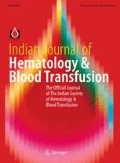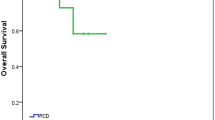Abstract
Secondary hypogammaglobulinemia (SHG) is characterized by a decrease in total serum immunoglobulin (Ig) levels and can lead to immunodeficiency associated with recurrent and severe infections and is a common complication of chronic lymphocytic leukaemia (CLL). SHG also increases with the treatment of CLL. Ibrutinib is one of these treatments and acts by inhibiting bruton tyrosine kinase. Twenty-seven patients with relapsed/refractory (R/R) CLL who received ibrutinib monotherapy were included. IgG levels, stage, bulky disease, previous treatments, genetics and laboratory features, overall survival (OS) and progression free survival (PFS) were compared with and without SHG. Nine patients (33.3%) had SHG and 18 patients (66.6%) didn’t have SHG. The mean IgG levels after ibrutinib treatment first, third, 6th and 12th months were 684, 531.3, 452 and 360 mg/dL respectively in SHG arm (p < 0.001) and 1156, 1058.2, 1012.8 and 886.9 mg/dL respectively in without SHG arm (p < 0.001). All patients with SHG had ibrutinib related other adverse effects(AEs) but 2 (11.1%) patients without SHG had AEs (p < 0.001). In SHG arm 7 (77.7%) had complete and partial remission but in other arm only 6 (33.3%) had (p: 0.029). There was no significant difference in OS and PFS (p values 0.95 and 0.64, respectively). IgG levels at the beginning of ibrutinib treatment is the best predicted value for SHG development in our study (p = 0.001). As a result, we reported a significant decrease in IgG values after ibrutinib monotherapy in R/R CLL patients. This decrease occurs every month after ibrutinib use, but after a maximum of 1 year.


Similar content being viewed by others
References
Hallek M, Cheson BD, Catovsky D, Caligaris-Cappio F, Dighiero G, Döhner H et al (2018) iwCLL guidelines for diagnosis, indications for treatment, response assessment, and supportive management of CLL. Blood J Am Soc Hematol 131(25):2745–2760
Hamblin A, Hamblin T (2008) The immunodeficiency of chronic lymphocytic leukaemia. Br Med Bull 87(1):49–62
Dhalla F, Lucas M, Schuh A, Bhole M, Jain R, Patel SY et al (2014) Antibody deficiency secondary to chronic lymphocytic leukemia: should patients be treated with prophylactic replacement immunoglobulin? J Clin Immunol 34(3):277–282
Mauro FR, Morabito F, Vincelli ID, Petrucci L, Campanelli M, Salaroli A et al (2017) Clinical relevance of hypogammaglobulinemia, clinical and biologic variables on the infection risk and outcome of patients with stage A chronic lymphocytic leukemia. Leuk Res 57:65–71
Freeman JA, Crassini KR, Best OG, Forsyth CJ, Mackinlay NJ, Han P et al (2013) Immunoglobulin G subclass deficiency and infection risk in 150 patients with chronic lymphocytic leukemia. Leuk Lymphoma 54(1):99–104
Parikh SA, Leis JF, Chaffee KG, Call TG, Hanson CA, Ding W et al (2015) Hypogammaglobulinemia in newly diagnosed chronic lymphocytic leukemia: natural history, clinical correlates, and outcomes. Cancer 121(17):2883–2891
Pan Z, Scheerens H, Li SJ, Schultz BE, Sprengeler PA, Burrill LC et al (2007) Discovery of selective irreversible inhibitors for Bruton’s tyrosine kinase. ChemMedChem Chem Enabl Drug Discov 2(1):58–61
Network NCC. Chronic lymphocytic leukemia, small lymphocytic leukemia 2019, December 20. Available from: https://www.nccn.org/professionals/physician_gls/pdf/cll.pdf
Eichhorst B, Robak T, Montserrat E, Ghia P, Hillmen P, Hallek M et al (2015) Chronic lymphocytic leukaemia: ESMO clinical practice guidelines for diagnosis, treatment and follow-up. Ann Oncol 26(5):v78–v84
Oken MM, Creech RH, Tormey DC, Horton J, Davis TE, McFadden ET et al (1982) Toxicity and response criteria of the Eastern Cooperative Oncology Group. Am J Clin Oncol 5(6):649–656
Parmelee PA, Thuras PD, Katz IR, Lawton MP (1995) Validation of the cumulative illness rating scale in a geriatric residential population. J Am Geriatr Soc 43(2):130–137
Sun C, Tian X, Lee YS, Gunti S, Lipsky A, Herman SE et al (2015) Partial reconstitution of humoral immunity and fewer infections in patients with chronic lymphocytic leukemia treated with ibrutinib. Blood J Am Soc Hematol 126(19):2213–2219
Shvidel L, Tadmor T, Braester A, Bairey O, Rahimi-Levene N, Herishanu Y et al (2014) Serum immunoglobulin levels at diagnosis have no prognostic significance in stage A chronic lymphocytic leukemia: a study of 1113 cases from the Israeli CLL Study Group. Eur J Haematol 93(1):29–33
Davey FR, Kurec AS, Tomar RH, Smith JR (1987) Serum immunoglobulins and lymphocyte subsets in chronic lymphocytic leukemia. Am J Clin Pathol 87(1):60–65
Rozman C, Montserrat E, Viñolas N (1988) Serum immunoglobulins in B-chronic lymphocytic leukemia. Nat Hist Prognost Sig Cancer 61(2):279–283
Griffiths H, Lea J, Bunch C, Lee M, Chapel H (1992) Predictors of infection in chronic lymphocytic leukaemia (CLL). Clin Exp Immunol 89(3):374–377
Doan A, Pulsipher MA (2018) Hypogammaglobulinemia due to CAR T-cell therapy. Pediatric Blood Cancer 65(4):e26914
Byrd JC, Furman RR, Coutre SE, Flinn IW, Burger JA, Blum KA et al (2013) Targeting BTK with ibrutinib in relapsed chronic lymphocytic leukemia. N Engl J Med 369(1):32–42
Dimou M, Iliakis T, Pardalis V, Bitsani C, Vassilakopoulos TP, Angelopoulou M et al (2019) Safety and efficacy analysis of long-term follow up real-world data with ibrutinib monotherapy in 58 patients with CLL treated in a single-center in Greece. Leuk Lymphoma 60(12):2939–2945
Winqvist M, Asklid A, Andersson P-O, Karlsson K, Karlsson C, Lauri B et al (2016) Real-world results of ibrutinib in patients with relapsed or refractory chronic lymphocytic leukemia: data from 95 consecutive patients treated in a compassionate use program. A study from the Swedish Chronic Lymphocytic Leukemia Group. Haematologica 101(12):1573–1580
Ysebaert L, Aurran-Schleinitz T, Dartigeas C, Dilhuydy MS, Feugier P, Michallet AS et al (2017) Real-world results of ibrutinib in relapsed/refractory CLL in France: early results on a large series of 428 patients. Am J Hematol 92(8):E166
O’Brien S, Furman RR, Coutre SE, Sharman JP, Burger JA, Blum KA et al (2014) Ibrutinib as initial therapy for elderly patients with chronic lymphocytic leukaemia or small lymphocytic lymphoma: an open-label, multicentre, phase 1b/2 trial. Lancet Oncol 15(1):48–58
Agostini C, Blau I-W, Kimby E, Plesner T (2016) Prophylactic immunoglobulin therapy in secondary immune deficiency—an expert opinion. Expert Rev Clin Immunol 12(9):921–926
Lachance S, Christofides A, Lee J, Sehn L, Ritchie B, Shustik C et al (2016) A Canadian perspective on the use of immunoglobulin therapy to reduce infectious complications in chronic lymphocytic leukemia. Curr Oncol 23(1):42
Kaveri S, Maddur M, Hegde P, Lacroix-Desmazes S, Bayry J (2011) Intravenous immunoglobulins in immunodeficiencies: more than mere replacement therapy. Clin Exp Immunol 164:2–5
Boughton B, Jackson N, Lim S, Smith N (1995) Randomized trial of intravenous immunoglobulin prophylaxis for patients with chronic lymphocytic leukaemia and secondary hypogammaglobulinaemia. Clin Lab Haematol 17(1):75–80
Chapel H, Dicato M, Gamm H, Brennan V, Ries F, Bunch C et al (1994) Immunoglobulin replacement in patients with chronic lymphocytic leukaemia: a comparison of two dose regimes. Br J Haematol 88(1):209–212
De La Torre I, Leandro MJ, Valor L, Becerra E, Edwards JC, Cambridge G (2012) Total serum immunoglobulin levels in patients with RA after multiple B-cell depletion cycles based on rituximab: relationship with B-cell kinetics. Rheumatology 51(5):833–840
Aittoniemi J, Miettinen A, Lainf S, Sinisalo M, Laippala P, Vilpo L et al (1999) Opsonising immunoglobulins and mannan-binding lectin in chronic lymphocytic leukemia. Leuk Lymphoma 34(3–4):381–385
Fabbiani M, Mondi A, Colafigli M, D’Ettorre G, Paoletti F, D’Avino A et al (2014) Safety and efficacy of treatment switch to raltegravir plus tenofovir/emtricitabine or abacavir/lamivudine in patients with optimal virological control: 48-week results from a randomized pilot study (Raltegravir Switch for Toxicity or Adverse Events, RASTA Study). Scand J Infect Dis 46(1):34–45
Acknowledgements
The author would like to acknowledge the assistance of Fatih Demirkan, MD and Leylagül Kaynar, MD in the editing process and Ali Ünal,MD in the submission process.
Funding
The authors declared that this study received no financial support.
Author information
Authors and Affiliations
Contributions
Each author has contributed substantially to the research, preparation and production of the paper and approves of its submission to the Journal. All authors: Final approval of manuscript. Concept: SÇ, LK; Design: SÇ; Data Collection or Processing: SÇ, MK, MB, ZTG; Analysis or Interpretation: SÇ, AÜ, MÇ, LK, FD; Literature Search: SÇ, LK; Writing: SÇ.
Corresponding author
Ethics declarations
Conflict of interest
The authors report no conflict of interest.
Additional information
Publisher's Note
Springer Nature remains neutral with regard to jurisdictional claims in published maps and institutional affiliations.
Supplementary Information
Below is the link to the electronic supplementary material.
Rights and permissions
About this article
Cite this article
Çelik, S., Kaynar, L., Güven, Z.T. et al. Secondary Hypogammaglobulinemia in Patients with Chronic Lymphocytic Leukemia Receiving Ibrutinib Therapy. Indian J Hematol Blood Transfus 38, 282–289 (2022). https://doi.org/10.1007/s12288-021-01466-1
Received:
Accepted:
Published:
Issue Date:
DOI: https://doi.org/10.1007/s12288-021-01466-1




